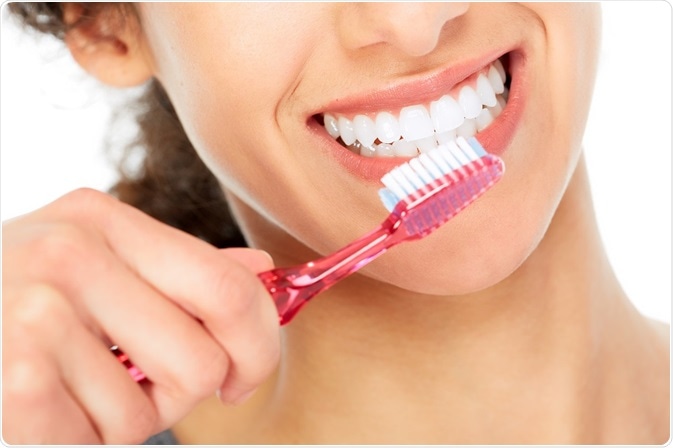A dental abscess is a localized collection of pus in the alveolar bone at the root apex of the tooth or structures supporting tooth (e.g. gums). It is a bacterial infection, which can be either painful or painless, that can affect both children and adults.
 Credit: kurhan/Shutterstock.com
Credit: kurhan/Shutterstock.com
Dental abscesses can manifest both in chronic and acute forms and are usually categorized depending on the site of occurrence:
- Periapical abscess: a common form of dental abscess occurring at the apex of a tooth root in the alveolar bone.
- Gingival abscess: an infection which occurs on the surface of the gum tissue that lines the teeth, creating swelling and pain in the gums.
- Periodontal abscess: an infection inside the deep gum pockets which mostly occurs if gingival abscess is left untreated.
Generally, dental abscesses are localized to the affected tooth or structures supporting the tooth, however suppuration (pus formation) can frequently spread to the nearby tissues causing fatal complications.
Signs and symptoms
Signs and symptoms of the acute dental abscess are pain (throbbing and continuous), swelling, erythema (redness) and fever. Patients may also experience sensitivity to hot and/or cold food/drinks, difficulty in opening mouth, an unpleasant taste in the mouth, difficulty in swallowing, bad breath and restlessness. However, a chronic abscess grows gradually and may not be associated with pain.
Bacteria majorly involved in causing dental abscesses comprise of the complex mix of strict anaerobes and facultative anaerobes.
Causes of dental abscesses
Bacteria are natural inhabitants of oral cavity (mouth). An improper oral hygiene can form a plaque on teeth and gums. Acids produced by the plaque can decay teeth or gums.
The main causes of dental abscesses are:
- Decayed or injured teeth (traumatic, broken or chipped): If left untreated, decaying teeth can stimulate an abscess. These conditions can lead to an opening in the tooth enamel (outermost and protective layer of tooth), permitting bacteria to infect the center of the tooth (the pulp) resulting in abscess at the apex of the tooth. In cases, where the infection is left untreated it spreads from root to the bone supporting the tooth.
- An infection in the gums and deep pockets inside the gums can also promote abscess.
- Infections post dental treatments such as extractions, implants and root canal treatment.
- An infection around the inflamed soft tissue surrounding the erupting tooth, which is referred as pericoronitis.
- Course tooth brushing.
It has also been observed that people with compromised immune system are more prone to infections. A compromised immune system, however, may not directly lead to dental abscess, but always increases the chances of infection.
Prevention of dental abscesses
Incidences of dental abscess can significantly be reduced if a good oral hygiene is maintained. Some of the key methods of preventing dental abscesses are given below.
Diet
Sugar is one of the major causes of tooth decay (caries). Sugar sticks to the tooth structures and accelerate tooth decay. Hence, avoid sugary, starchy and sticky foods to lower the risk of developing a dental abscess.
Using a fluoride toothpaste
Fluorides are substances, which protect the teeth against mineral loss, contribute remineralization of enamel and prevent formation of acids. Use fluoridated drinking water hence water fluoridation is the most effective ways to reduce caries. Start using a fluoridated toothpaste.
Good oral hygiene
Regular and proper brushing of the teeth, twice daily is recommended for maintaining good oral hygiene. Start using dental floss or an inter-dental brush for proper cleaning in between teeth and gums. Seek a dental professional help for correct brushing and flossing techniques. Also, replace toothbrush every three or four months.
Regular dental check-ups
Visit your dentist for regular checkups. Seek a professional advice every 6 months. Consult the dentist immediately in case of trauma happens to the tooth.
Further Reading
Last Updated: Feb 26, 2019